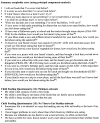Predictors and consequences of food neophobia and pickiness in young girls
- PMID: 12778039
- PMCID: PMC2532522
- DOI: 10.1053/jada.2003.50134
Predictors and consequences of food neophobia and pickiness in young girls
Abstract
Objective: Vegetable intake among children is well below recommended levels. We assessed whether food neophobia and pickiness contribute to low vegetable intake in school-aged girls and if there are distinct predictors for neophobia and pickiness. Children with food neophobia are reluctant to eat new foods whereas picky children resist eating many familiar foods. Design/subjects Participants were 192 7-year-old girls and their parents, recruited for a study of girls' nutrition and development. We examined relationships between food neophobia and pickiness and assessed whether these variables predicted girls' vegetable consumption and predictors of food neophobia and pickiness.
Analyses: The data were analyzed using a two-step process. First, we used a two-way analysis of variance to assess whether girls who scored high or low on food neophobia and pickiness measures had different levels of vegetable consumption. We used multiple regression analysis to determine predictors of food neophobia and pickiness in the girls.
Results: Girls with both food neophobia and pickiness consumed fewer vegetables (1.1+/-0.1) than girls with neither neophobia nor pickiness (1.6+/-0.1). Neophobia and pickiness were modestly related in this sample, but had different predictors. Girls with food neophobia were more anxious and had mothers with food neophobia. Picky girls had mothers with less variety in their vegetable intake (r=-0.22) and mothers who perceived their family to have little time to eat healthful foods (r=0.36). In addition, picky eaters were breastfed for fewer than 6 months (r=-0.25). Pickiness was predicted primarily by environmental or experiential factors subject to changes; neophobia was predicted by more enduring and dispositional factors.
Applications: Because food neophobia and pickiness negatively influence vegetable intake, intervention strategies to increase vegetable intake should focus on predictors of neophobia and pickiness, especially those subject to change.
Figures


Similar articles
-
Cross-sectional exploration of maternal reports of food neophobia and pickiness in preschooler-mother dyads.J Am Coll Nutr. 2012 Jun;31(3):152-9. doi: 10.1080/07315724.2012.10720022. J Am Coll Nutr. 2012. PMID: 23204151
-
Parental pressure, dietary patterns, and weight status among girls who are "picky eaters".J Am Diet Assoc. 2005 Apr;105(4):541-8. doi: 10.1016/j.jada.2005.01.029. J Am Diet Assoc. 2005. PMID: 15800554 Free PMC article.
-
Food neophobia and 'picky/fussy' eating in children: a review.Appetite. 2008 Mar-May;50(2-3):181-93. doi: 10.1016/j.appet.2007.09.009. Epub 2007 Sep 29. Appetite. 2008. PMID: 17997196 Review.
-
Picky eating and food neophobia: Resemblance and agreement in parent/young adult dyads.Appetite. 2018 Jul 1;126:36-42. doi: 10.1016/j.appet.2018.02.021. Epub 2018 Feb 27. Appetite. 2018. PMID: 29496603
-
Risk Factors and Consequences of Food Neophobia and Pickiness in Children and Adolescents: A Systematic Review.Foods. 2024 Dec 30;14(1):69. doi: 10.3390/foods14010069. Foods. 2024. PMID: 39796359 Free PMC article. Review.
Cited by
-
Child food neophobia is heritable, associated with less compliant eating, and moderates familial resemblance for BMI.Obesity (Silver Spring). 2013 Aug;21(8):1650-5. doi: 10.1002/oby.20369. Epub 2013 Jul 2. Obesity (Silver Spring). 2013. PMID: 23512929 Free PMC article.
-
Complementary Feeding Methods, Feeding Problems, Food Neophobia, and Picky Eating among Polish Children.Children (Basel). 2023 Dec 29;11(1):45. doi: 10.3390/children11010045. Children (Basel). 2023. PMID: 38255359 Free PMC article.
-
Diet, sensitive periods in flavour learning, and growth.Int Rev Psychiatry. 2012 Jun;24(3):219-30. doi: 10.3109/09540261.2012.675573. Int Rev Psychiatry. 2012. PMID: 22724643 Free PMC article. Review.
-
Electrodermal activity as an index of food neophobia outside the lab.Front Neuroergon. 2024 Jan 3;4:1297722. doi: 10.3389/fnrgo.2023.1297722. eCollection 2023. Front Neuroergon. 2024. PMID: 38234468 Free PMC article.
-
Girls' picky eating in childhood is associated with normal weight status from ages 5 to 15 y.Am J Clin Nutr. 2016 Dec;104(6):1577-1582. doi: 10.3945/ajcn.116.142430. Epub 2016 Oct 26. Am J Clin Nutr. 2016. PMID: 27797710 Free PMC article.
References
-
- Potter J, Finnegan J, Guinard J-X, Huerta E, Kelder S, Kristal A, Kumanyika S, Lin R, Motsinger B, Prendergast F, Sorensen G. 5 A Day For A Day For Better Health Report. Bethesda, MD: National Institutes of Health, National Cancer Institute; 2000.
-
- Van Duyn MAS, Pivonka E. Overview of the health benefits of fruit and vegetable consumption for the dietetics professional: Selected literature. J Am Diet Assoc. 2000;100:1511–1521. - PubMed
-
- Munoz KA, Krebs-Smith SM, Ballard-Barbash R, Cleveland LE. Food intakes of US children and adolescents compared with recommendation. Pediatrics. 1997;100:323–329. - PubMed
-
- Carlson A, Lino M, Gerrior S, Basiotis P. Report Card on the Diet Quality of Children Ages 2–9. Alexandria, VA: US Dept of Agriculture, Center for Nutrition Policy and Promotion; 2001.
MeSH terms
Grants and funding
LinkOut - more resources
Full Text Sources
Medical

